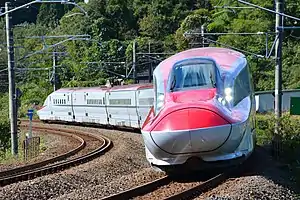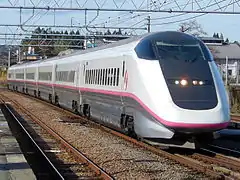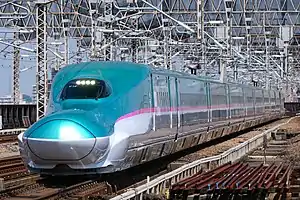 An E6 series train on a Komachi service in October 2016 | |
| Overview | |
|---|---|
| Service type | Shinkansen |
| Status | Operational |
| Locale | Tōhoku Shinkansen, Akita Shinkansen |
| First service | 22 March 1997 |
| Current operator(s) | JR East |
| Route | |
| Termini | Tokyo Akita |
| Distance travelled | 670.2 km (416.4 mi) |
| Service frequency | Hourly |
| On-board services | |
| Class(es) | Standard + Green |
| Catering facilities | Trolley service |
| Technical | |
| Rolling stock | E6 series |
| Track gauge | 1,435 mm (4 ft 8+1⁄2 in) |
| Electrification | 25/20 kV AC overhead |
| Operating speed |
|
The Komachi (こまち) is a high-speed shinkansen service between Tokyo and Akita in Japan, operated by the East Japan Railway Company (JR East) since March 1997. It is the only shinkansen service that runs on the Akita Shinkansen, and uses E6 series trains. Between Tokyo Station and Morioka, it couples with Tōhoku Shinkansen E5 series Hayabusa and formerly E2 series for E3 series respectively. After Morioka, the Komachi service continues along standard gauge tracks that were converted from narrow gauge. Because it then runs on tracks that have grade crossings, its maximum speed from Morioka to Akita is 130 km/h (80 mph), compared to 320 km/h (200 mph) on the Tohoku Shinkansen.
The Komachi service was named after a famous poet from the area, Ono no Komachi, whose name (小町) is also synonymous with "belle" or "beauty" in Japanese.
Station stops
Komachi services stop at the following stations on the Akita Shinkansen between Morioka and Akita.[1] For details of station stops between Tokyo and Morioka, see the Hayabusa articles.
(*) Not served by all trains.
Train formations

Since 15 March 2014, most Komachi services have operated by seven-car E6 series trainsets with running at a maximum speed of 320 km/h (200 mph) on the Tohoku Shinkansen coupled to E5 series Hayabusa trainsets.[2] Car 11, the "Green" (first class) car, is at the Tokyo end. All seats are reserved and no-smoking.[1]
| Car No. | 11 | 12 | 13 | 14 | 15 | 16 | 17 |
|---|---|---|---|---|---|---|---|
| Class | Green | Standard | Standard | Standard | Standard | Standard | Standard |
| Facilities | Wheelchair space | Wheelchair space / Cardphone | Cardphone |
E3 series

Komachi services were also operated by five-car E3 series trainsets (later augmented to six cars).[2] These sets were formed as shown below, with car 11, the "Green" (first class) car, at the Tokyo end. All seats were reserved and no-smoking.[1]
| Car No. | 11 | 12 | 13 | 14 | 15 | 16 |
|---|---|---|---|---|---|---|
| Class | Green | Standard | Standard | Standard | Standard | Standard |
| Facilities | Wheelchair space | Wheelchair space | Cardphone | Cardphone |
Accommodation
 E6 series Green car interior with 2+2 seating
E6 series Green car interior with 2+2 seating E6 series standard class car interior with 2+2 seating
E6 series standard class car interior with 2+2 seating
History
Komachi services began on the newly opened Akita Shinkansen line from the start of the revised timetable on 22 March 1997 using a fleet of 16 new 5-car E3 series trains running at a maximum speed of 275 km/h (170 mph) on the Tohoku Shinkansen.[3] The name Komachi was officially announced in July 1996.[4] Services initially consisted of 13 return workings daily between Tokyo and Akita, and one return working between Sendai and Akita. Most trains ran coupled with 200 series Yamabiko trainsets between Tokyo and Morioka, but three return workings ran coupled with newly introduced E2 series sets, running at a maximum speed of 275 km/h (170 mph) between Utsunomiya and Morioka, and giving a fastest journey time of 3 hours 49 minutes between Tokyo and Akita (an average speed of 163.4 km/h).[4] The train services proved popular, and from the December 1998 timetable revision, an addition return working was added, and the E3 series trains were lengthened to six cars each.[4] From the December 1999 timetable, all Komachi services ran together with E2 series Yamabiko trains, allowing overall journey times to be reduced, with a typical journey time of 4 hours 4 minutes.[4]
From 16 March 2013, new Super Komachi (スーパーこまち) services started, using new E6 series trains running at a maximum speed of 300 km/h (185 mph) on the Tohoku Shinkansen.[5] Initially, a fleet of four trains was used to operate four return services daily between Tokyo and Akita. The fastest journey time was reduced to 3 hours 45 minutes, 5 minutes faster than the fastest previous Komachi services.[5] From the start of the revised timetable on 15 March 2014, all services were operated by E6 series trains, and the name was returned to simply Komachi.[2] At the same time, the maximum speed on the Tohoku Shinkansen (on the section between Utsunomiya and Morioka[6]) was further raised to 320 km/h (200 mph).[2]
See also
- Akita Relay, a temporary limited express service that operated to Akita while the Akita Shinkansen was being constructed
- List of named passenger trains of Japan
References
- 1 2 3 JR Timetable, March 2013 issue
- 1 2 3 4 3月15日ダイヤ改正と各地の話題 [15 March timetable revision and topics from around the regions]. Tetsudō Daiya Jōhō Magazine (in Japanese). Vol. 43, no. 361. Japan: Kōtsū Shimbun. May 2014. pp. 12–13.
- ↑ JR新幹線&特急列車ファイル [JR Shinkansen & Limited Express Train File]. Japan: Kōtsū Shimbun. 2008. p. 16. ISBN 978-4-330-00608-6.
- 1 2 3 4 Teramoto, Mitsuteru (July 2001). 国鉄・JR列車名大辞典 [JNR & JR Train Name Encyclopedia]. Tokyo: Chuoshoin Publishing Co., Ltd. p. 239. ISBN 4-88732-093-0.
- 1 2 秋田新幹線の新しい列車名は"スーパーこまち"に [New trains on Akita Shinkansen to be named 'Super Komachi']. Japan Railfan Magazine Online (in Japanese). Japan: Koyusha Co., Ltd. 6 November 2012. Retrieved 6 November 2012.
- ↑ 2014年3月ダイヤ改正について [March 2014 timetable revision details] (PDF). News release (in Japanese). Japan: East Japan Railway Company. 20 December 2013. pp. 2–3. Retrieved 20 December 2013.
External links
- JR East E6 series Komachi (in Japanese)



